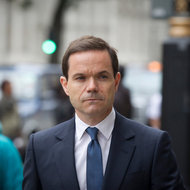 Simon Dawson/Bloomberg NewsJerry del Missier, former chief operating officer of Barclays.
Simon Dawson/Bloomberg NewsJerry del Missier, former chief operating officer of Barclays.
LONDON — A former senior Barclays executive involved in the interest rate manipulation scandal is set to receive a $13.6 million payout, a compensation package that could add to the scrutiny of the British bank.
Jerry del Missier, the bank’s former chief operating officer who resigned this month, has been a central figure in the firestorm.
In June, British and American authorities fined Barclays for reporting false rates to increase profits and make the bank look healthier during the financial crisis. According to regulatory documents, a senior executive — later identified as Mr. del Missier — asked bank employees to lower the firm’s submissions of the London interbank offered rate, or Libor.
The Barclays case is the first major action stemming from a multiyear inquiry into rate-rigging that has ensnared more than 10 banks. Since the Barclays settlement, lawmakers have taken aim at regulators and bank executives.
In Congressional testimony on Thursday, Timothy F. Geithner, the Treasury secretary, vowed that authorities would forcefully pursue criminal investigations. Mr. Geithner, who ran the Federal Reserve Bank of New York during the financial crisis, has taken heat for not halting the illegal actions back then, despite evidence of problems. Instead, he advocated broad reforms to the rate-setting process.
“I believe that we did the necessary and appropriate thing,” he said on Thursday before a Senate panel, the second Congressional hearing this week to focus on Mr. Geithner.
Mr. del Missier, who has held a number of top positions at the bank, has also defended his actions to lawmakers. In testimony to the British Parliament this month, the Canadian-born executive said he believed he was following the instructions of senior government officials. “I expected that the Bank of England’s views would be incorporated into our Libor submissions,” he said. “The views would have resulted in lower submissions.”
Regulators say Mr. del Missier misinterpreted a discussion between Robert E. Diamond Jr., the former chief executive of Barclays, and Paul Tucker, the deputy governor of the Bank of England, the country’s central bank.
Pay issues have dogged Barclays for months.
This year shareholders balked at the size of management’s pay packages. In April, the top executives pledged to give up some of their bonuses if the bank did meet certain performance goals.
Shortly after the Barclays settlement, Mr. Diamond and Mr. del Missier agreed to forgo their annual payouts. Days later, both of them resigned over their roles in the rate-manipulation scandal. To help quell public anger, Mr. Diamond agreed to forfeit deferred stock bonuses of up to $31 million.
The former chief could still collect one year of salary and a cash payment collectively worth $3.1 million. Mr. del Missier is set to receive $13.6 million, according to a person with direct knowledge of the matter. The news of Mr. del Missier’s payout was reported earlier by Sky News.
Barclays is now looking to replace many of its senior officials. Along with Mr. Diamond and Mr. del Missier, its chairman, Marcus Agius, has said he will leave once a new chief executive is in place. On Wednesday, Alison Carnwath, chairwoman of the firm’s compensation committee, also gave up her position, citing undisclosed personal reasons.
A spokesman for Barclays declined to comment. A representative for Mr. del Missier was not immediately available for comment.
Article source: http://dealbook.nytimes.com/2012/07/26/former-top-barclays-official-in-line-for-13-6-million-payout/?partner=rss&emc=rss